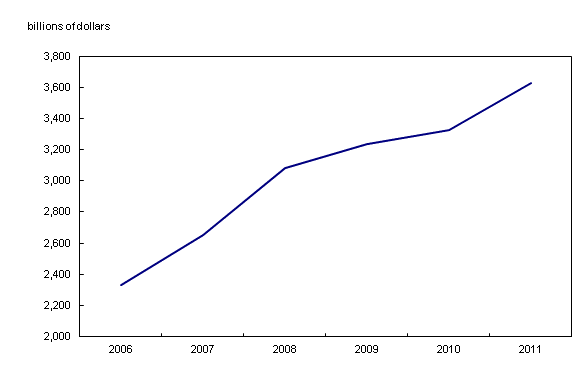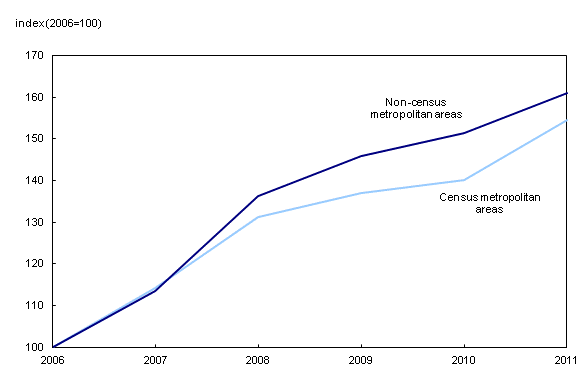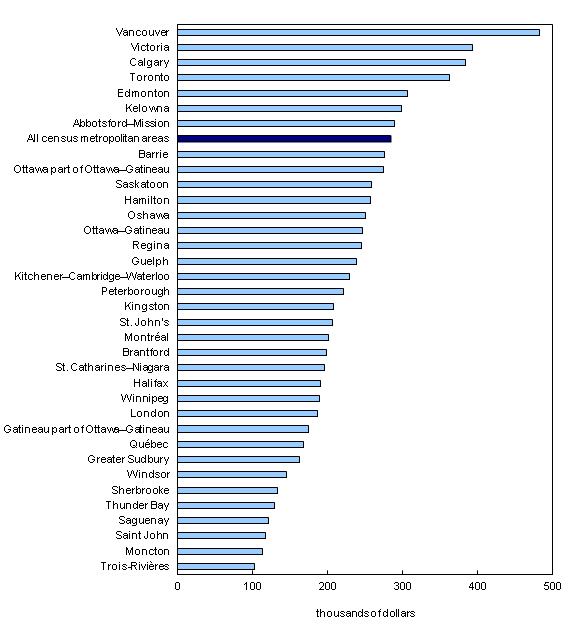Residential property assessment values, 2006 to 2011
Archived Content
Information identified as archived is provided for reference, research or recordkeeping purposes. It is not subject to the Government of Canada Web Standards and has not been altered or updated since it was archived. Please "contact us" to request a format other than those available.
Released: 2013-04-25
Residential properties in the provinces had a total market value of $3,630.9 billion in 2011, growing 56.0% in five years.
Nationally, growth in the total value of residential properties accelerated in 2011 after slowing substantially in 2009 and 2010, during the economic downturn. In 2007 and 2008, annual increases were well above the 11.2% average from 2006 to 2011.
Provincially, the total value of residential properties rose in every province from 2006 to 2011. The fastest growth occurred in Saskatchewan (+132.6%), where values more than doubled, followed by Newfoundland and Labrador (+100.0%) and Alberta (+97.0%).
The slowest rates of growth were in Prince Edward Island (+40.6%) and Ontario (+42.9%). Even so, Ontario accounted for one-third of the overall growth in the total value of residential properties during the five-year period.
On a year-over-year basis, the total market value of residential properties increased 9.2% from 2010 to 2011. The highest growth rates were recorded in Newfoundland and Labrador (+15.0%), Manitoba (+12.0%) and Ontario (+9.9%). In 2011, the market value of the residential stock in Ontario was $1,468.6 billion, about 40% of the national total.
Slowdown in growth mainly attributable to three provinces
Nationally, prior to accelerating in 2011, the growth in the value of residential property was 5.0% in 2009 and 2.7% in 2010. These growth rates were much lower than the increases of 16.1% in 2008 and 14.0% in 2007.
Alberta, British Columbia and Ontario contributed the most to the slowdown in growth in residential property values in 2009 and 2010.
Prior to 2009, Alberta had recorded the highest rates of growth among the provinces, with the value of the residential stock increasing by nearly half in just 2008. In 2009, however, the growth in property values in Alberta slowed to 1.9% and in 2010, values fell 8.0%. This was the only decline in the total value of residential properties among the provinces.
In British Columbia, growth was strong in 2007 and 2008 before it nearly halted in 2009 and 2010. Growth accelerated in 2011.
Ontario exhibited a relatively moderate upward trend in values during this five-year period. The total value of residential properties in the province rose 10.5% in 2008 and 3.9% in 2009. Growth remained weak in 2010 before strengthening in 2011.
Property values in some provinces did not follow the slowing trend during the downturn. In Manitoba and Saskatchewan, the total value of residential properties grew strongly in 2009 and slowed in 2010.
In Newfoundland and Labrador, the total value of properties showed robust growth from 2008 to 2011. In both 2010 and 2011, the province recorded the highest growth rate of any province.
In Quebec, growth in the total value of properties remained relatively moderate until 2009. It slowed slightly in 2010, before strengthening in 2011.
Census metropolitan areas
Residential properties in Canada's 33 census metropolitan areas (CMAs) had a total market value of $2,729.2 billion in 2011, a 54.4% increase from 2006. They accounted for three-quarters of the national total in 2011.
Over the same five-year period, the total value of residential properties in the regions outside the CMAs increased 60.9%.
The highest growth rates among CMAs from 2006 to 2011 were in Saskatoon, Regina and Edmonton, where values more than doubled. During the period, property values declined only in Windsor (-0.5%).
From 2010 to 2011, the total value of residential properties increased 10.3% in the CMAs, while regions outside the CMAs recorded a 6.2% increase.
Property values increased in all CMAs in 2011. The largest gains occurred in St. John's, Saguenay and Québec, and the smallest in Kelowna, Saint John and Moncton.
In 2011, the three largest CMAs combined—Toronto, Vancouver and Montréal—accounted for 56.9% of total property values.
In 2011, properties in Toronto had a total market value of $752.7 billion, Vancouver, $458.5 billion, and Montréal, $341.5 billion.
Robust advances in values per private dwelling
Data from the 2006 and 2011 censuses show that the number of private dwelling units increased 7.3% to 14.5 million nationally. Using these dwelling counts, residential property values per private dwelling increased 45.3% from $172,000 to $250,000. This implies that much of the growth in property values per private dwelling resulted from increases in prices.
The provinces with the highest values per private dwelling in 2011 were British Columbia, at $396,600, and Alberta, at $313,400. Prince Edward Island had the lowest, at $91,200.
Census metropolitan area residential property values per private dwelling
Residential property values per private dwelling amounted to $283,700 in the CMAs in 2011. The highest values were in British Columbia and Alberta, where all CMAs had values above the national average.
The Vancouver CMA had the highest per dwelling value by far, at $482,800, followed by Victoria, at $393,400, Calgary, at $384,500, and Toronto, at $362,000. Values per dwelling were lowest in Trois-Rivières, Moncton and Saint John.
Note to readers
This is Statistics Canada's first release of estimates for residential property assessment values.
The Property Assessment Values Program is primarily intended to meet data requirements from Finance Canada for the Federal Equalization Program. For the time being, this program focuses entirely on residential property assessment.
Data for this release are provided by provincial and municipal assessment entities and are based on their assessment rolls.
Residential property comprises all types of property categorized as residential for assessment purposes in the majority of provinces. It includes single and multi-family properties, farm residences, cottages and vacation homes, mobile homes, institutional and communal residences, and vacant lands that are lawfully usable for residential purposes.
For a given reference year, the residential property value reflects the volume of the stock on January 1 of that year, and the price condition in the market on July 1 of the preceding year.
For more information on the different approaches on measuring the stock of residential real estate, please consult Latest Developments in the Canadian Economic Accounts (Catalogue number13-605-X).
Contact information
For more information, contact us (toll-free 1-800-263-1136; infostats@statcan.gc.ca).
To enquire about the concepts, methods or data quality of this release, contact Haaris Jafri (613-951-4307) or Yu (Stanley) Su (613-951-6386), Investment, Science and Technology Division.
- Date modified:




